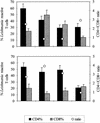T-cell-mediated immune responses in patients with cutaneous or mucosal leishmaniasis: long-term evaluation after therapy
- PMID: 11874860
- PMCID: PMC119941
- DOI: 10.1128/cdli.9.2.251-256.2002
T-cell-mediated immune responses in patients with cutaneous or mucosal leishmaniasis: long-term evaluation after therapy
Abstract
T-cell immune responses in patients with cutaneous leishmaniasis (CL) and mucosal leishmaniasis (ML) were studied during the active disease, at the end of therapy, and 1 to 17 years posttherapy (long-term follow-up). Lymphocyte proliferative responses, phenotypic characterization of CD4(+) and CD8(+) Leishmania-reactive T cells, and cytokine production were assayed. Patients with active ML and CL showed higher proportions of CD4(+) than CD8(+) T cells. In CL, the healing process was associated with a decrease of CD4(+) and an increase of CD8(+), leading to similar CD4(+) and CD8(+) proportions. This pattern was only seen in ML after long-term therapy. Long-term follow-up of patients with CL showed a positive CD4(+)/CD8(+) ratio as observed during the active disease, although the percentages of these T cell subsets were significantly lower. Patients with CL did not show significant differences between gamma interferon (IFN-gamma) and interleukin-5 (IL-5) production during the period of study. Patients with active ML presented higher IFN-gamma and IL-5 levels compared to patients with active CL. IL-4 was only detected during active disease. Patients long term after cure from ML showed increasing production of IFN-gamma, significant decrease of IL-5, and no IL-4 production. Two apparently beneficial immunological parameters were detected in tegumentary leishmaniasis: (i) decreasing proportions of CD4(+) Leishmania-reactive T cells in the absence of IL-4 production associated with cure of CL and ML and (ii) decreasing levels of IL-5 long after cure, better detected in patients with ML. The observed T-cell responses maintained for a long period in healed patients could be relevant for immunoprotection against reinfection and used as a parameter for determining the prognosis of patients and selecting future vaccine preparations.
Figures



References
-
- Bottrel, R. L. A., W. O. Dutra, F. A. Martins, B. Gontijo, E. Carvalho, M. Barral-Netto, A. Barral, R. P. Almeida, W. Mayrink, R. Locksley, and K. J. Gollob. 2001. Flow cytometry determination of cellular sources and frequencies of key-cytokine-producing lymphocytes directed against recombinant LACK and soluble Leishmania antigen in human cutaneous leishmaniasis. Infect. Immun. 69:3232-3239. - PMC - PubMed
-
- Brodskyn, C. I., A. Barral, V. Boaventura, E. Carvalho, and M. Barral-Netto. 1997. Parasite-driven in vitro human lymphocyte cytotoxicity against autologous infected macrophages from mucosal leishmaniasis. J. Immunol. 159:4467-4473. - PubMed
-
- Callan, M. F. C., N. Annels, N. Steven, L. Tan, J. Wilson, A. J. McMichael, and A. B. Rickinson. 1998. T cell selection during the evolution of CD8+ T cells memory in vivo. Eur. J. Immunol. 28:4382-4390. - PubMed
-
- Carvalho, E. M., W. D. Johnson, E. Barreto, P. D. Marsden, J. L. M. Costa, S. Reed, and H. Rocha. 1985. Cell mediated immunity in American cutaneous and mucosal leishmaniasis. J. Immunol. 135:4144-4148. - PubMed
Publication types
MeSH terms
Substances
LinkOut - more resources
Full Text Sources
Research Materials

